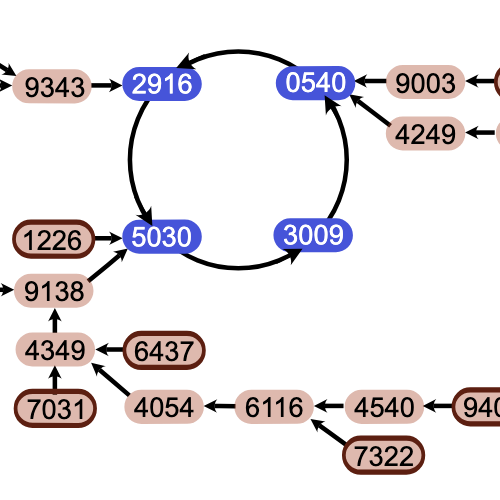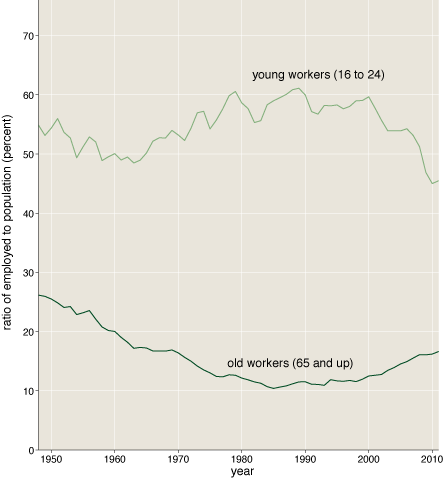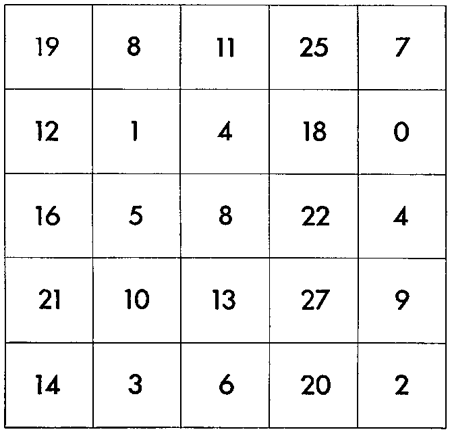Math Baubles
by Brian Hayes
Published 15 December 2006

Yesterday’s mail brought the latest issue of Focus, the magazine of the Mathematical Association of America. On the cover is a photograph of a gold icosahedron offered for auction last year at Sotheby’s. One reason for the MAA’s interest in this artifact is that the association’s emblem is an icosahedron. But there’s also a mathematical puzzle connected with it. On each of the 20 triangular faces of the object is inscribed a number. The numbers are listed in the Sotheby catalogue (and in Focus) as follows: 11, 20, 21, 31, 41, 51, 61, 71, 81, 91, 101, 201, 301, 401, 501, 601, 701, 801, 901 and 202. Actually, there are two puzzles connected with this set of figures. The lesser puzzle is why the authors of the catalogue chose to list the numbers in this almost-but-not-quite ascending sequence. The greater puzzle is what the numbers mean in their original context.
What is that context? The Focus article, written by Harry Waldman, gives this account of the provenance of the gold polyhedron:
This 17th or 18th century piece of Islamic art had been part of the treasury of Tipu Sultan, who died at the hands of the British in India at the Battle of Seringapatam, in May 1799. The victors then claimed possession of this and other valuables of the vanquished army of Tipu.
Thus the object is presumed to be of Indian origin and a few centuries old. It is a hollow box, with a hinged lid comprising one pentagonal pyramid of five triangles. The numerals on the faces are written in a script that resembles the one Karl Menninger terms East Arabic, with a centered dot for zero, but there are some variations from the letterforms seen in modern Arabic scripts. Since I don’t read any of the languages that use such numerals, I found the inscriptions very difficult to interpret. (I’m particularly iffy about the 7s and the 4s.)
What could the numbers mean? I spent a goodly part of the night puzzling over this question, but I don’t have a clue. The numbers fall readily into two series of nine (11, 21, …, 91 and 101, 201, …, 901) plus two oddballs—or should we call them evenballs?—20 and 202. But that classification has no obvious significance. Ideally, one would like to identify a pattern related to the symmetries of the icosahedron—maybe 12 overlapping groups of 5 numbers each—but I can find nothing of the kind. I thought it might be helpful to know how the numbers are arranged on the icosahedron. Working from the two photographs in Focus and a couple more on the Net, I put together the map shown below. But I have to emphasize that this reconstruction is tentative; it could be full of errors; the two numbers in gray are totally conjectural; and the white question marks denote faces that I can’t see at all in any of the photos. Annoyingly, the hidden faces seem to be those with the evenballs 20 and 202. (The orientation of the map puts the five triangles of the arctic cap at the top; the blue line represents the hinge.) The arrangement of the numbers—if I have read them correctly—seems orderly enough, but also uninformative.

When I first looked at the list of numbers, I thought it might be more promising if only we could reverse the digits to get 11, 12, …, 19 and 101, 102, …, 109. And, I thought, with a flicker of hope: Since there’s an Arabic connection here, maybe that’s not so far-fetched. But Menninger’s book Number Words and Number Symbols puts the kibbosh on that idea. Even though Arabic script reads right to left, numbers embedded in it are written from left to right, and there’s evidence this has always been so. “Many a neophyte,” Menninger scornfully notes, “has tried to reverse the digits this way….”
Waldman in Focus is circumspect about the prospect of solving the mystery: “Research… has failed to offer clues as to the meaning of these inscriptions.” On the other hand, the National Gallery of Scotland, which has had the icosahedron on exhibit, apparently has access to deeper insights:
A considerable amount of research has been devoted to the interpretation of the 20 numbers on this box, which at first appear to be unrelated. However, they have all been shown to demonstrate accurate values of Pi and Pi squared, and Phi and Phi squared, as well as the roots of 2, 3, and 5. It is possible that other mathematical relationships are concealed within these numbers.
A final note: The MAA declined the offer to purchuse Tipu Sultan’s polyhedral trinket. The asking price was 200,000 pounds sterling. Presumably the item is still available, so if you have someone on your holiday gift list who might appreciate such a bauble, now’s the time to make a bid.
Update 2006-12-30: Thanks to information from “A Numbered Icosahedron from India: Mystery & Meaning,” by Paul Bien, I have filled in the remaining blanks in the folding net above.
Responses from readers:
Please note: The bit-player website is no longer equipped to accept and publish comments from readers, but the author is still eager to hear from you. Send comments, criticism, compliments, or corrections to brian@bit-player.org.
Publication history
First publication: 15 December 2006
Converted to Eleventy framework: 22 April 2025




No comment on the ethicality of buying stolen goods?
I think you just did.